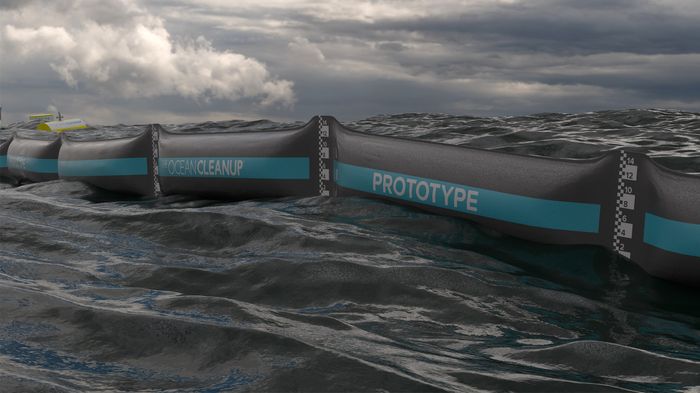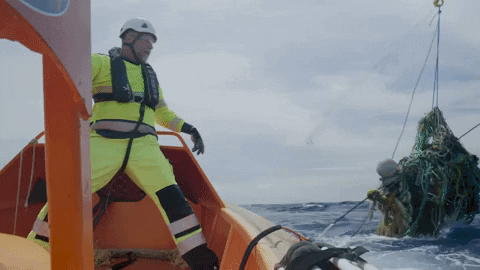
The Ocean Cleanup Unveils First Prototype
Back to pressFirst sea trial of ocean cleanup system to be deployed this week
THE HAGUE, June 22, 2016 – The Ocean Cleanup, the Dutch foundation developing advanced technologies to rid the oceans of plastic, today unveiled its North Sea prototype. When installed later this week, the prototype will become the first ocean cleanup system ever tested at sea. Two of The Ocean Cleanup’s main partners, the Dutch government, and world-renowned dredging and marine contractor Royal Boskalis Westminster N.V., were represented at the unveiling.
The prototype will be installed in the North Sea, 23 km (12 NM) off the Dutch coast, where it will remain for one year. The objective is to test how The Ocean Cleanup’s floating barrier fares in extreme weather at sea – the kind of conditions the system will eventually face when deployed in the Great Pacific Garbage Patch.
The 100 meter-long barrier segment to be deployed in the North Sea this week will help validate the survivability of the system. Sensors will track every motion of the prototype and the loads it is subjected to. The data gathered will enable engineers to develop a system fully resistant to severe conditions during the cleanup of the Great Pacific Garbage Patch. At the North Sea test site, conditions during a minor storm are more severe than those in exceptionally heavy storms (occurring once every 100 years) in the Pacific Ocean.
The Ocean Cleanup’s cleaning technology makes use of long floating barriers which act as an artificial coastline, passively catching and concentrating ocean debris. The system is powered by the ocean’s natural currents. Testing the barriers is important because of their crucial role in the cleanup concept. Although some trash may be caught during the North Sea prototype test, collecting plastic is not its objective.
Boyan Slat, CEO and founder of The Ocean Cleanup, said “This is a historic day on the path toward clean oceans. A successful outcome of this test should put us on track to deploy the first operational pilot system in late 2017.” He also notes that a successful test does not necessarily mean the prototype will survive. “I estimate there is a 30% chance the system will break, but either way it will be a good test.”
Dutch Environment Minister Sharon Dijksma said: “The Ocean Cleanup is an inspiring example of how we can tackle the growing problem of ocean pollution. I hope that with the help of the Dutch government, Boyan’s prototype will turn out to be the successful solution for cleaning up the mid-ocean gyres. This is crucial to prevent permanent damage to the environment and marine life, due to the degradation and fragmentation of plastic waste materials.”
Peter Berdowski, CEO of Boskalis, said: “It has been inspiring to work with The Ocean Cleanup. Now that everything is ready, we are looking forward to the really exciting next step, with the transportation and installation of the barrier. I wish Boyan and his team success with their journey towards a plastics-free ocean.”
###
PRESS CONTACT
CFF Communications
Jan van Ewijk / Claire Verhagen
press@theoceancleanup.com
T: +31(0)20 575 40 10
Photos and videos can be downloaded fromhttp://www.theoceancleanup.com/press/
About The Ocean Cleanup
The Ocean Cleanup develops advanced technologies to rid the world’s oceans of plastic.
Founded in 2013 by then 18-year-old Boyan Slat, The Ocean Cleanup now employs approximately 50 engineers and researchers. The foundation is headquartered in Delft, The Netherlands.
Instead of going after plastic debris with vessels and nets – which would take many thousands of years and billions of dollars to complete – The Ocean Cleanup is designing a network of extremely long floating barriers that will remain stationary in the water, enabling the ocean to concentrate the plastic using its own currents.
In preparation for full deployment in 2020, The Ocean Cleanup in the summer of 2015 organized the Mega Expedition, in which 30 vessels crossed the Great Pacific Garbage Patch simultaneously to produce the first high-resolution map of the plastic pollution problem. Meanwhile, the team has advanced its design through a series of rapid iteration scaling-up tests. The North Sea prototype is the latest step in this process.
